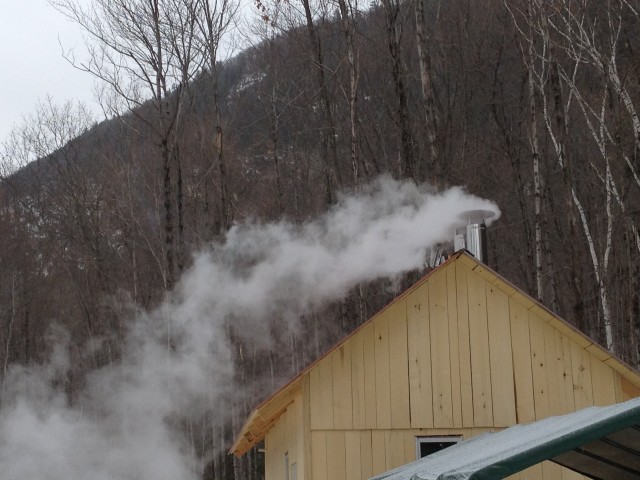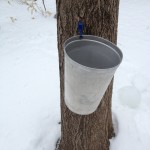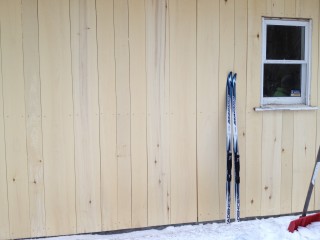Maple: The sugar harvest

The first food.
This is how I once heard a Vermont Public Radio guest expert, on sugaring, maybe, describe maple syrup years ago as I maneuvered the Outback down some unpaved Green Mountain back road on the way to who-knows-where. And that simple, pregnant phrase has stuck with me ever since.
Long before the snowpack melts and pours into a thousand rivulets that feed boulder-strewn mountain streams, Mother Nature cues the maple trees to nurse. It happens while all the green things are still sleeping in the woods – the fiddlehead ferns tightly curled beneath the soil, the ramps in colonies of bulbs waiting patiently to burst fragrantly forth, the mushrooms, in their mystery, hiding in wait. Those who grocery shop in the woodlands, settlers back then and wildcrafters now, still have a good couple months to sit tight until their baskets can be filled. But for now, the sap is flowing. The sugar bush is the first to wake and rise to the duty of providing freshly harvested wild food.
 Dented silver buckets hang like the Tin Man’s stockings from iron taps carefully pierced into sugar maple bark, ready to receive each morning. As the sun rises, the warmth coaxes sap to flow through the vasculature of each proud tree, the first crystalline drop hitting the bottom of an empty pail with a triumphant, quiet “whomp.” More follow, slowly, trickling in their own due time until there’s enough to collect. One by one the buckets are gently lifted from their tap hooks, emptied carefully into a tank pulled from tree to tree through the snowy woods by horse-drawn sled, ATV, or pickup, then placed back on the tree to receive again.
Dented silver buckets hang like the Tin Man’s stockings from iron taps carefully pierced into sugar maple bark, ready to receive each morning. As the sun rises, the warmth coaxes sap to flow through the vasculature of each proud tree, the first crystalline drop hitting the bottom of an empty pail with a triumphant, quiet “whomp.” More follow, slowly, trickling in their own due time until there’s enough to collect. One by one the buckets are gently lifted from their tap hooks, emptied carefully into a tank pulled from tree to tree through the snowy woods by horse-drawn sled, ATV, or pickup, then placed back on the tree to receive again.
There’s an irreverence surrounding the making of syrup, an unspoken ceremony at the sugarhouse as tree water turns into the richest wine. It’s a patient process, part science and part intuition, to boil sap for hours until it reduces down to thick shades of amber, caramel, or near molasses.
 As the sap simmers the sugar maker, the soothsayer here, holds court with any number of neighbors, kinfolk, curious strangers, and apprenticing young ones who have wandered into the sugar shack, beckoned by the steam billowing from the hatch in the roof that signals across the countryside that sap is being made. They all come to rally around this rural ritual of spring, sit in a humid mist laced with wood smoke, sugar, and a little backwoods magic, and melt off a long winter’s worth of cold body tension that wears down even the hardiest of New Englanders.
As the sap simmers the sugar maker, the soothsayer here, holds court with any number of neighbors, kinfolk, curious strangers, and apprenticing young ones who have wandered into the sugar shack, beckoned by the steam billowing from the hatch in the roof that signals across the countryside that sap is being made. They all come to rally around this rural ritual of spring, sit in a humid mist laced with wood smoke, sugar, and a little backwoods magic, and melt off a long winter’s worth of cold body tension that wears down even the hardiest of New Englanders.
Every so often the boiler-in-chief rises from a cast-off chair to stoke the fire, check progress, add another can to the 12-pack tower growing outside the back door, then set back down to pepper the conversation with commentary about past seasons when the sap flowed generously and those sparse few years when it definitely did not. Time moves differently in the sugar shack, conveniently, as days lengthen as if to accommodate the boiling.
And then it happens. When the apothecary collection of instruments and generations of passed-down knowledge deem the syrup done, those lucky enough to bear witness get a sip of that first food borne of the woods, a sweet toast to the passage of winter and blessings for the harvest to come.
Header photo credit: Morse Maple Farm, Montpelier, VT. Go there if you can.
